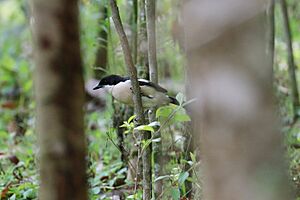Ethiopian boubou facts for kids
Quick facts for kids Ethiopian boubou |
|
|---|---|
 |
|
| Conservation status | |
| Scientific classification | |
| Genus: |
Laniarius
|
| Species: |
aethiopicus
|
| Synonyms | |
|
Laniarius ferrugineus aethiopicus (Gmelin, 1788) |
|
The Ethiopian boubou (Laniarius aethiopicus) is a cool bird that belongs to the Malaconotidae family. These birds are found in parts of Africa, including Eritrea, Ethiopia, northwest Somalia, and northern Kenya. They love living in moist savanna areas, which are like grasslands with scattered trees.
This boubou has a pretty look! Its chest and belly are often a soft pinkish color. It also has a thin stripe on its wings, which stretches across the middle and larger wing feathers. You won't see any white tips on its outer tail feathers.
Contents
About the Ethiopian Boubou
The Ethiopian boubou is a type of bushshrike, known for its interesting calls. These birds are often shy and like to hide in thick bushes, making them a bit tricky to spot!
Where Do They Live?
Ethiopian boubous are found in specific parts of eastern Africa. They prefer places with lots of trees and bushes, like savannas and woodlands. This habitat gives them good places to find food and stay safe.
What Do They Look Like?
These birds are medium-sized. Their feathers are mostly black on top, but their underside has a lovely pinkish color. The thin white stripe on their wings helps them stand out. They have strong beaks, which are perfect for catching insects.
Scientific Classification
Learning about how animals are named helps us understand them better. Scientists use special names to keep track of every living thing.
How the Ethiopian Boubou Got Its Name
The Ethiopian boubou was first officially described in 1789 by a German scientist named Johann Friedrich Gmelin. He gave it the scientific name Turdus aethiopicus at first. Later, it was moved into the genus Laniarius, which is where it is today. This genus was created in 1816 by a French bird expert, Louis Pierre Vieillot.
Closely Related Birds
For a long time, the Ethiopian boubou was thought to be the same as a few other boubou birds, like the tropical boubou and the black boubou. But in 2008, scientists did special DNA studies. These studies showed that the Ethiopian boubou is actually its own unique species. This means it's different enough from the others to have its own separate classification.


